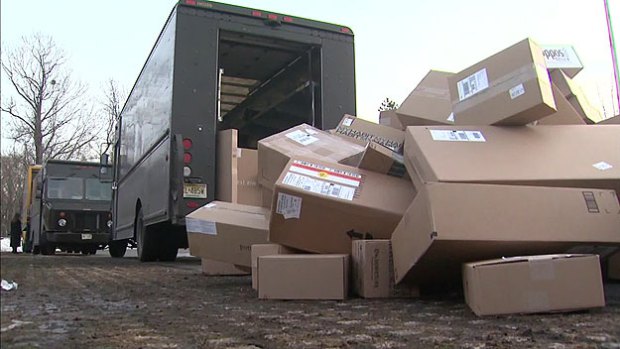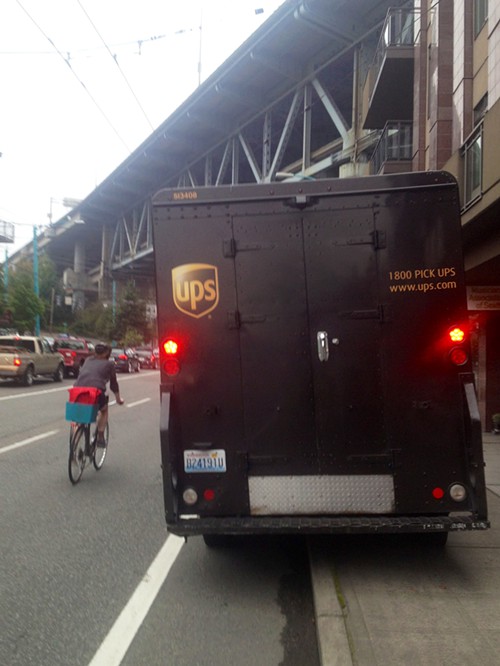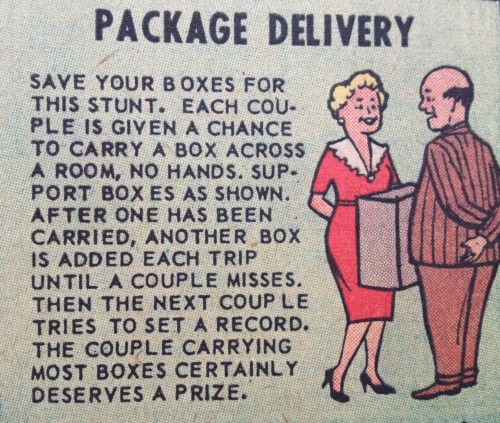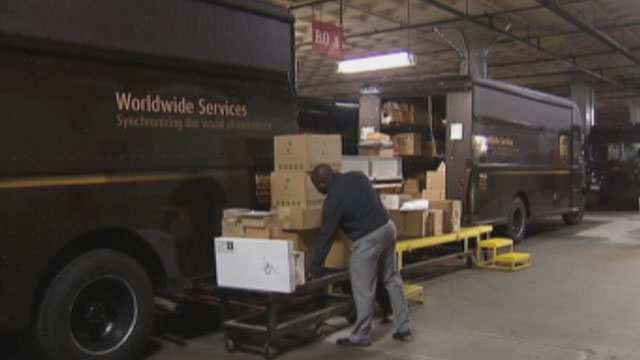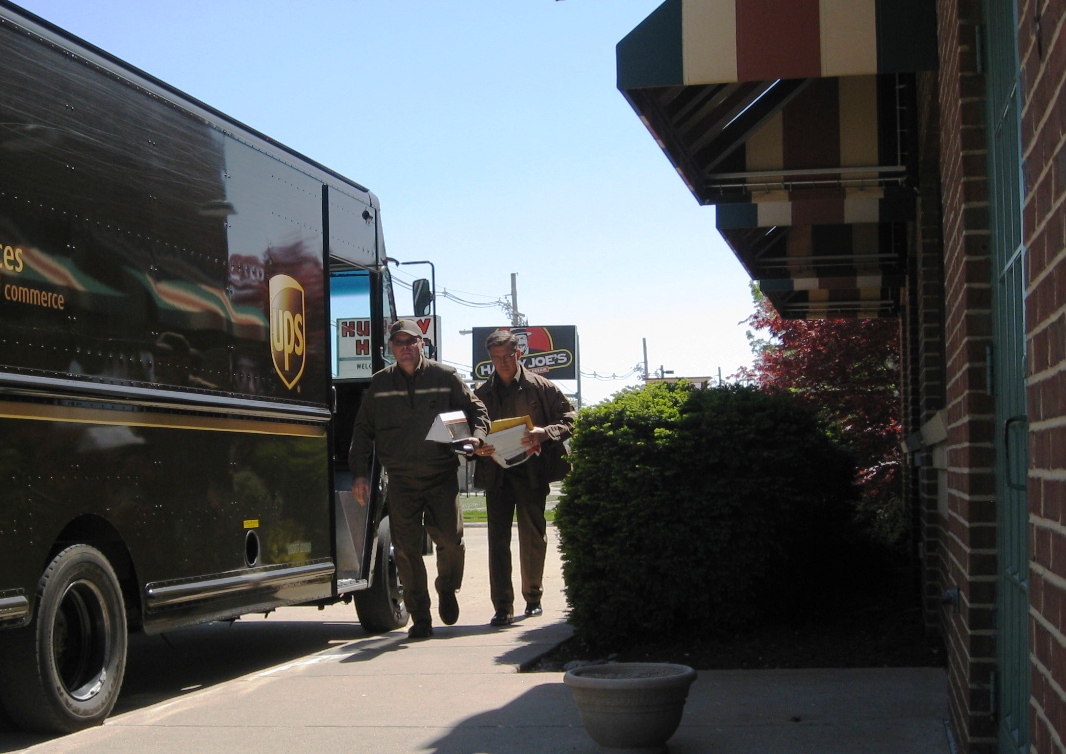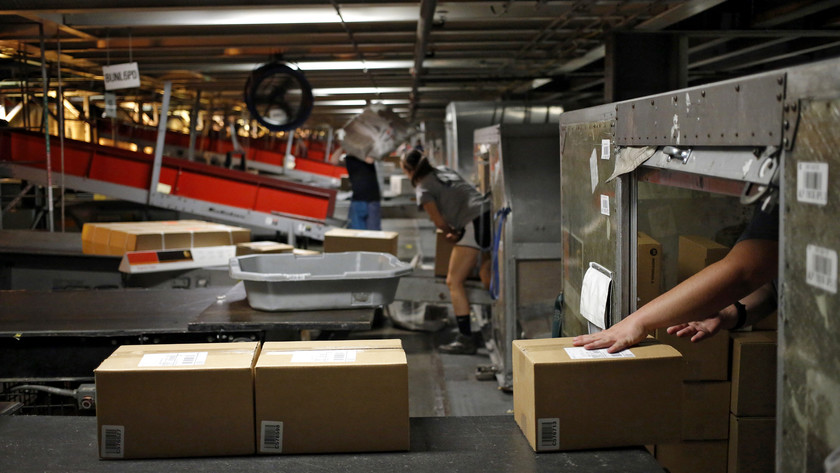Category Archives: UPS
Here’s your split
To Park or Not to Park
For Your Next Party
Supe Working Grievance?
Takes two
That’s his job
UPS Turns Parking Lots Into Sorting Centers to Add Speed
Outside a brick-and-mortar sorting facility in suburban Atlanta, UPS has built its own Christmas village.
It’s functional, if not festive: the company welded together aluminum segments and placed them atop a poured concrete floor to create a makeshift package-sorting facility in an employee parking lot. Inside, conveyor belts whisk packages toward the gaping delivery bays and awaiting delivery trucks.
These “mobile distribution center villages” deployed around the U.S. are designed to help avert a repeat of last year’s Christmas delays that saw thousands of gifts delivered a day or more late. United Parcel Service Inc. (UPS) is in crunch time. It expects six days this month to surpass its single-busiest shipping day of last year. Things should peak today with an estimated 34 million items dropped off at homes and businesses.
“It all goes back to 585 million packages in the month of December,” spokesman Dan Cardillo said. “It’s a lot more packages than we usually handle.”
The center in Roswell, Georgia, resembles a metal outdoor self-storage unit and even though it’s equipped with space heaters, a morning visit last week felt as chilly inside as the 28 degrees Fahrenheit (minus 2.2 degrees Celsius) outside.
The temporary structure means a 40 percent boost in capacity to process holiday gifts in surrounding ZIP codes for the world’s biggest delivery company.
Real Test
UPS has spent the past 12 months preparing for this. Memories of last year, when it missed some Christmas deadlines because of bad weather and a rush of last-minute online orders, are fresh. The company took an image beating and was forced to make $50 million in refunds because of missed deadlines. In response, UPS moved up its plans for $500 million in capital projects to accommodate this year’s peak season, and it dedicated another $175 million of operating expenses to it.
The moves are paying off as UPS navigates today’s crush of packages, said Andy McGowan, a spokesman for the company.
“While today will be UPS’s busiest day of the year, we expect packages to be delivered as planned,” he said. “All UPS air and ground operations are operating smoothly, demonstrating the value of the additional investments in capacity and technology.”
On-Time Rate
During the week of Dec. 7 to Dec. 13, UPS deliveries were on-time 95 percent of the time, according to package tracking company ShipMatrix Inc. That’s an improvement over the same week a year earlier, when UPS’s on-time rate was 92 percent.
“This year, because they’ve done planning, they are sustaining the service levels,” said Satish Jindel, a logistics consultant from Sewickley, Pennsylvania, and president of ShipMatrix.
UPS shares rose 0.9 percent to $112 at the close in New York. They gained 6.6 percent this year compared with a 12 percent increase in the Standard & Poor’s 500 Index.
The mobile villages are a piece of UPS’s strategy to make things right this year, along with hiring 95,000 seasonal workers to sort boxes and deliver packages. That exceeds the peak-season hiring done by Amazon.com Inc. (AMZN) and Macy’s Inc. UPS operated one mobile village last year, and rolled out another 14 across the country this year.
Early Start
In Roswell, 22 miles north of Atlanta, the 100 employees at the mobile village supplement the work done at a 225,000-square-foot (20,900-square-meter) permanent sorting facility next door. As many as 90 trucks a day pull into the delivery bays, awaiting fresh loads of tricycles, Christmas sweaters and electronics bound for Roswell and nearby Marietta. That adds to the 200 vehicles the regular processing center accommodates.
On a recent morning, village workers dressed in jackets, gloves and hoodies picked items off conveyor belts. A label affixed to each box tells employees which truck to load the box in and what shelf to put it on. Next-day items due at offices and homes by 10:30 a.m., go up front, less pressing deliveries go in back.
Work at UPS starts early, with some employees arriving at about 3:30 a.m., expected to load three trucks in a five-hour shift.
Cardillo, the spokesman, declined to give UPS’s startup cost for each mobile village.
‘Moved Anywhere’
“These temporary delivery centers provide us enormous flexibility,” Cardillo said by e-mail. “This not only includes during peak season, but any time of year. These MDCs can be moved anywhere around the country to set up temporary operations.”
In January, UPS will take down its aluminum panels and conveyor belts, leave the concrete foundation intact and it will return to a parking lot. Until then, employees are parking at a concert amphitheater nearby and shuttling to their jobs in school buses.
“We will be getting right back to work servicing customers we serve every day,” Cardillo said. “The peak holiday deliveries will be done, but the returns pick up right away.”
To contact the reporter on this story: Michael Sasso in Atlanta at msasso9@bloomberg.net
IBT on possible pension cuts
IBT: We encourage everyone to remain calm
Tens of thousands of Teamsters and retirees voiced their strong opposition over the last weeks and months to pension legislation that was included in the Omnibus spending bill. Unfortunately, the legislation was sneaked into the bill literally in the dark of night and through procedural chicanery that didn’t even allow for a separate vote or give us the opportunity to strip the provisions from the bill and passed the Senate late Saturday evening. We encourage you to make one more call to the White House at 202-456-1414 to encourage President Obama to rethink his present course of action and veto it when it reaches his desk.
Over the next days and weeks, we will be providing more information on the timing of this legislation and what you can do to continue this fight. It is important to note that no pension cuts are going into effect immediately.
We understand that this is a very difficult time for all Teamsters, especially retired Teamsters who are dependent on their pension. We encourage everyone to remain calm while we continue our efforts to protect every member and their pension.
Please check out www.Teamster.org for the most up-to-date information that we know on the issue.
Republican Pension Cuts and You
FAQs: What the Pension Bill Means for You
The ink is still drying on the pension cut deal that was attached in the dead of night to Congress’s spending bill. Some FAQs can be answered now; TDU will provide updated information as it becomes available
Does this bill mandate pension cuts?
No. This bill permits “deeply troubled” pension plans, those which could become insolvent over the next 10-20 years, to cut already-earned pensions of retirees and active workers. These cuts will be up to the trustees of the pension fund; the trustees are 50% union officials, and 50% management reps. No cuts will go into effect immediately.
Could this affect other Teamsters, or just those in the Central States Pension Fund?
Most Teamster funds will be completely unaffected. The Western Conference Fund is in the “green zone.” Other large Teamster funds, such as New England, Local 705, Local 710, Local 804, Local 177, Joint Council 83, and most others will be unaffected, even if they are in the “red zone.” For example, Local 804 just won significant pension benefit increases in their recent contract.
Certain deeply troubled small Teamster funds may be affected. New York Local 707’s pension fund is nearly insolvent, as freight jobs dried up, and their biggest employer YRC got concessions to drastically cut their contributions to all pension funds. So we expect the Local 707 Fund to consider pension cuts.
How will it affect Teamsters in the Central States Fund?
The Director of the Fund, Thomas Nyhan, was a principal lobbying force for this bill, and has stated that CSPF will impose cuts on retirees and active Teamsters. The Trustees of the fund, who are 50% management and 50% Teamster officials politically aligned with Hoffa, support the bill and support cutting pensions. They will make the decisions on when, who, and how much to cut, within the bounds of the new legislation.
Have Central States officials indicated how much they will cut?
In the past, Al Nelson, the Benefit Services Director of Central States, stated that a cut of about 30% would be what is needed.
But now the legislation has changed that. It requires that workers (so-called “orphans”) who retired from companies that went bankrupt (such as CF, Allied Systems, Preston, or Hostess, for example) be cut first and hardest.
This horrendous language is contained on page 81 of the pension legislation.
At this point, no one knows what the cuts will be, because we do not know how this legislation will be interpreted or applied. The next move will be by the Central States trustees.
The legislation also has protective language for some retirees: those over 80, those receiving only a disability pension, and to a partial degree, those who are 75-80.
How will this affect UPS retirees in the Central States Fund?
UPS bought enough influence in Congress to save an estimated $2 billion through a special interest loophole that shifts the company’s cost burdens on to Teamster retirees who will face additional pension cuts as a result.
On pages 81-82 of the pension legislation there is a loophole dedicated to exactly one corporation, UPS. This loophole means that CSPF will probably not be able to cut the pensions of UPS workers who retired after January 1, 2008, because they are “Priority 3” in order of cuts (the best priority).
UPS retirees do not benefit one cent from this loophole because their pensions are already protected by the contract. Article 34, Section 1 of the current UPS master agreement, requires UPS to make up the full pension to UPSers if CSPF imposes cuts.
UPS’s special interest loophole means the company won’t have to make up for any pension cuts. As a result, all non-UPS retirees will face $2 billion more in pension cuts. Retirees are footing the bill so that UPS doesn’t have to pay the obligations it agreed to in the contract.
It is not known if the “UPS Exemption” also covers UPS Teamsters who retired from Central States before January 1, 2008. These Teamster retirees deserve to know their status and if they may face pension cuts.
Will Teamsters and retirees get a vote prior to any cuts?
A ‘fact sheet’ issued by the bills sponsors claims that workers and retirees will get a vote before cuts could be made. But this is not true because of additional loopholes in the deal.
First, those in Central States can be deprived of a vote, because it is a large fund and its failure could seriously impact the Pension Benefit Guaranty Corporation (PBGC).
To add insult to injury: a majority of all participants – not just voters – would be required for a No result. In other words, not voting would count as a vote in favor of a pension cut!
If Central States makes these cuts, will the fund be secure?
Maybe. Certainly slashing the benefits would improve the bottom line. But in the long run a pension plan needs contributing employers, and here is where the Hoffa administration has failed badly. They severely undermined the Fund by letting UPS pull out 45,000 participants, and they have not organized new companies into the fund. Central States set up a special “hybrid” kind of plan to allow new companies to join the fund with zero withdrawal liability. It was designed for organizing. But it has not been used for new companies. That has to change.
Will Teamster officials and Central States officials have to take cuts?
That remains to be seen. Because their work for the fund or local unions will not count as “orphan” time, they may or may not face cuts. But Thomas Nyhan, the fund director, is paid $662,060, so he probably isn’t worried. Neither is Hoffa: he is in the lucrative Family Protection Plan, which pays far more than a working Teamster could dream of collecting.
Sign up for email updates at www.tdu.org and like us on facebook.
The Pension Rights Center’s backgrounder on the pension-cut bill


